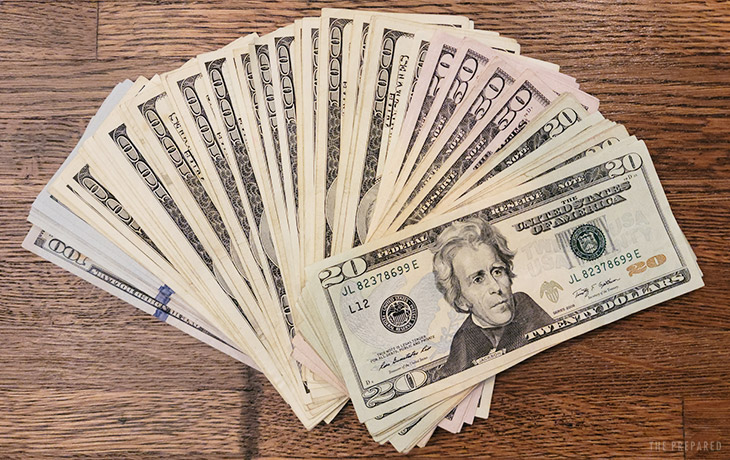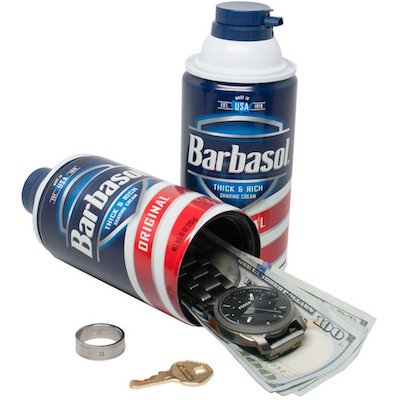A lot of people ask “how much cash should I have?”
There is no universal answer since everyone’s financial situation is different. The closest thing to a simple answer are rules of thumb around having enough cash to cover 1-6 months worth of your normal living expenses.
Some rough examples:
- Someone making $50k/yr with average debt and savings might have $500 in hard cash and $2,000 in a rainy-day savings account.
- Someone making $100k/yr with average savings/retirement might keep $3,000 on hand and another $10,000 in the bank.
- Someone with a $1M net worth might have $10,000 on hand and $25,000 in liquid savings.
If you have credit card debt or other forms of high-interest debt, you shouldn’t keep more than two weeks worth of hard cash until you’ve built a better financial foundation. See personal finance for preparedness.
“Cash” can mean different things. There are two different types in this context:
- Physical money you can hold and take with you. Sometimes called hard currency.
- Liquid money held by a financial institution, like your savings account, or cryptocurrency. It’s “liquid” because you could turn it into physical money without much difficulty, but it would involve some extra steps. Assets like stocks and real estate are not liquid in this context.
Both types have a role in prepping, so you should have a mix of both. Most people have more cash in the bank than they do at home.
The benefits to tangible money in your possession are obvious, especially when you need the cash instantly, a disaster has made ATMs and banks inaccessible, or there’s value in going off grid without needing to contact banks (eg. domestic violence).
Example: Some of the writers for this guide used on-hand emergency cash to buy food when the 2020 Nashville Christmas bombing took down ATMs and the phone/data network (which banks rely on) in their area.
But there are plenty of emergencies where the liquid cash in your bank is just as helpful, if you can make a trip to the ATM or wait a few days for a bigger withdrawal.
If you suddenly lost your job, for example, cash in the bank is just as helpful as the hard cash at home. Maybe the hard cash covers the first few hours or days while you get access to the larger balance in the bank.
Things like stocks and real estate aren’t considered liquid because it creates a taxable event and you might not want to be forced into selling while the market is down. You can create usable cash either way, but the timing might not be great, so we avoid it. On the extreme end, you might not be able to sell those assets during a major emergency at all.
Your minimum goal is to cover at least a few weeks’ worth of expenses
The spirit is similar to why the beginner’s emergency preparedness guide focuses on building up a few week’s worth of supplies like food and water — most emergencies are over within a few weeks, so it makes sense to use that as a baseline for cash, too.
The simplest thing for most people is to start with enough cash to keep them going for one month, adding up their normal expenses like housing, food, bills, insurance, education, etc. Once you hit that milestone, just keep extending the ‘runway’ up to 3, 6, or even 12 months.
Tip: If your budget is tight, start with enough for two weeks of food. It might take a while to get evicted from your apartment, for example, but at least you won’t go hungry in the meantime.
Holding too much cash
Taking hard and bank cash together, most people shouldn’t have more than 5% of their net worth in cash that’s just sitting there earning nothing.
Holding money in the form of cash, rather than in the stock market or some other kind of investment, means the value of your cash goes down over time. That’s due to erosion from inflation.
For example: If you put a $100 bill under your mattress in 1999 because you were worried about Y2K, today it would be worth about $63. But if that $100 was put into a total stock market fund, it would be worth about $532 today.
So there’s a “cost” to holding simple cash, and that means you don’t want to get too cash heavy.
You can think of this as if you were paying a monthly insurance premium in order to have the ‘insurance’ of cash. On average, holding $10k of cash ‘costs’ you around $60 per month in the form of lost money.
There’s also the simple risk of holding so much physical cash that something like a house fire wipes out your savings. Or worse, word gets out and you become an attack target.
A higher percentage of cash is okay if you’re in or close to retirement. Generally speaking, your investments should become less risky (and thus less profitable) as you get older, since you have fewer years ahead of you to make up for the losses of a bad investment or economic downturn. It’s risky to walk into retirement with 100% of your assets tied up in investments.
Once living needs are covered, extra cash helps you take advantage of bad situations
You could take the “X months of coverage” idea and just keep going, holding enough cash to cover years of expenses. But think about it… it would have to be a really bad scenario where you’re depending on saved cash to meet daily needs for more than a year.
Imagine you and your spouse lose your jobs due to a 2008-style financial crisis. Having a year of expenses saved up was very helpful for people during that uncertain time.
But if you had extra cash above and beyond that year’s worth, you could also take advantage of the dip — it’s the old saying “when there’s blood in the streets, buy real estate!” This is why wealthier people keep a bit of cash around even though they’ve got the basic ‘rainy day’ living needs covered.
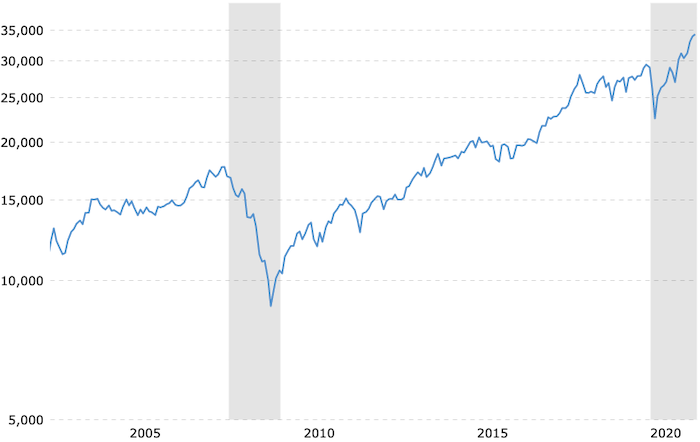
Cash that wasn’t tied up in assets like stocks or real estate wasn’t affected by the market’s 40% crash in 2008. So any extra cash laying around could be used to buy in at the bottom of the market or get a great deal on a new home — think of it as a rare opportunity to buy things on sale for the few people who have free cash.
Those crashes are usually the last time you want to sell assets like stocks in order to free up cash for living expenses, since the stock prices are depressed and you’re taking a big loss. It’s almost always better to hold assets during a big dip, so avoiding the need to sell for cash flow is helpful.
Using emergency cash
Besides opportunistically buying assets while they’re on sale, common things people spend rainy-day cash on (and US averages during non-panic times) are:
- $80 per night for lodging
- $25 per day for food and drinks
- $40 to fill up a tank of gas
- $500 for unexpected car brake repairs
- $400 for doctors office visit without insurance
- $300 to fix a tooth cavity without insurance
- $200 for eyeglasses without insurance
- $2,000 for an emergency room visit without insurance
- $4,200 per month for in-home medical care
- $8,000 per month for nursing home care (Medicare copay is ~$180/day)
- $1,000 to cover the deductible of a homeowner’s insurance policy
- $1,500 for a new water heater
- An unexpected tax bill
- Hiring help to haul away debris from a storm
- Paying your daughter’s horrible boyfriend to stay away
How to keep money in the bank the right way
Your goal is to keep cash liquid — meaning you can get to it very quickly without much or any penalty or market fluctuations — and hopefully let it grow over time to counteract inflation.
While the classic checking or savings account at your local bank does the liquid part well, and it’s fine if that’s where you keep your rainy day fund, in recent years they’ve paid such little interest on savings accounts that it’s essentially zero. The best returns are usually found through online-only banks or smaller community banks and credit unions.
Tip: Check Bankrate for the latest info.
Some banks offer better interest rates if you lock your money up for a period of time, such as with Certificates of Deposit (CDs). Avoid those, unless they have a generous policy of letting you get your money back early.
Money market funds are a type of savings account that often pays a better interest rate than a basic savings account, sometimes in exchange for a limit on how many transactions you can do per month. If you already have an investment brokerage, see if they offer better-than-average rates on their money accounts — which sometimes come with check-writing abilities — such as Vanguard’s VMRXX.
If you’re into cryptocurrency, a new way to hold “cash” (in crypto form) that’s under your control while also generating a decent return — around 6% as of this writing — is by staking Ether as a participant in the decentralized network. Here’s more about staking ETH on your own or via a custodian like Coinbase.
Denominations
Try to imagine realistic scenarios where you’d use this cash. On the one hand, you don’t want to use a $100 bill to buy a $1 drink if you can’t get change — and who knows if change will be possible at that moment. On the other hand, you don’t want to be penny wise and pound foolish, and you need to consider that the person you’re buying from might not want tons of small $1 bills or one huge $1,000 bill.
The largest common US currency is a $100 bill. There are technically larger bills, eg. $500 and $1,000, but they’re not appropriate for this purpose and are rare enough that if you tried to use one, the seller likely wouldn’t believe it’s real.
Even if you were carrying a lot of cash, say $10k, a stack of $100 bills is still reasonable enough to put in a backpack or even hide on your body.

If you want to carry more, once you go above $100 bills it’s probably time to switch to something like 1-ounce gold bullion pieces, diamonds, or other forms of compact wealth.
The bulk of your cash should be in $20s, $50s, and $100s. There’s no harm in having smaller bills kept at home, but you’re not going to want to bug out with a wad of $1s and $5s. Even simple vending machines can often take a $20 bill if needed.
Again, there’s no right answer here, but an example of spreading out $2,000 in cash:
- $1,400 in $100s = 14
- $500 in $20s = 25
- $100 in $10s = 10
Cash weight and sizes
Every US note weighs one gram. It would take 454 notes to equal one pound. Each US note is the same size: 2.61 inches wide x 6.14 inches long x 0.0043 inches thick.
Depending on the mix of denominations you use, it’s possible to carry a bit of cash without taking much space or weight in your bag.
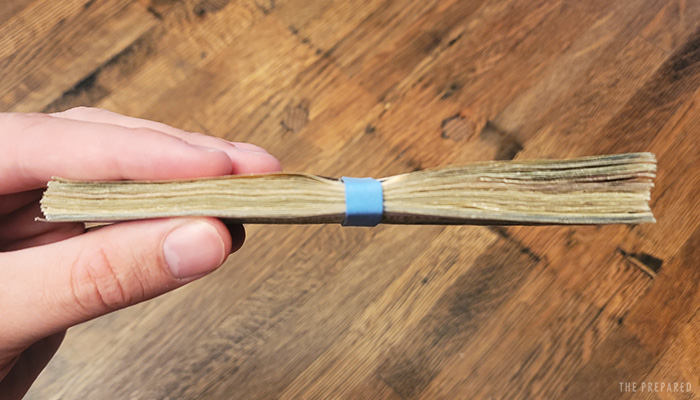
$5,000 example:
- 43 $100s + 8 $50s + 15 $20s
- Weighs 2.35 oz (67 grams) including rubber band
- 3/8 inch tall when laid flat and compressed
$2,000 example:
- 10 $100s and 50 $20s
- Weighs 2.1 oz (60 grams) including rubber band
- 6/16 inch tall when flat and compressed
How to store and carry cash
There’s a million different ways to accomplish the same goal: If you make it even just a little bit harder than average for someone to find your money, they likely won’t.
Because cash doesn’t take much space, you can get creative in hiding it around your home and go-bags. Besides the classic hollowed-out book, there are tons of products designed to look like everyday items so you can hide your cash in plain sight, like this cliche Barbasol concealment can.
Your only real concern is water ruining the notes over time, so try to use ziploc bags and avoid areas with obvious moisture.
The good news is that it’s easy to replace damaged money (at least in the US). As long as you have at least 50% of a physical bill, you can walk into a bank and swap it for a new one.
Obvious choices are safes and lockboxes — but be sure they are secured to something immovable, because house thieves are known to just take portable containers so they can work on opening them in private later.
In a SHTF situation where you’re away from home and depending on the cash you’re carrying, you want to be smart about how you’re carrying it in case you’re robbed. Look for compartments in your backpack or gear you can sneak cash into, rather than having a normal wallet sitting right inside the front zipper pouch — unfortunately, if you find yourself in something like a FEMA shelter, people are known to snoop.
An easy trick is using wallets primarily meant for travelers to protect their cash when visiting places known for muggings and pickpockets. We’ve used this Eagle Creek Hidden Pocket when visiting Brazil, for example, which hangs off a belt loop so the wallet is hidden inside of your pants. It even has a black and brown loop, so you can use whichever loop best blends in with your belt.
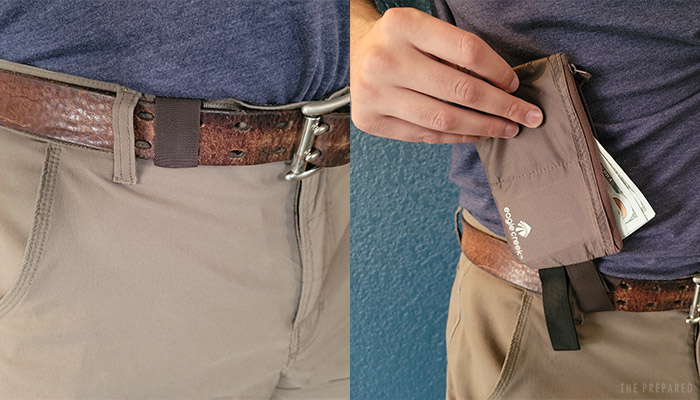
Especially when paired with a fake wallet in your normal back pocket or purse that only has a few dollars in it, you can just hand the fake wallet over and the thief will likely move on. Or you can use your normal wallet in your normal pocket/purse, so buying things throughout the day isn’t as cumbersome, but have the backup emergency cash in the hidden pocket.
